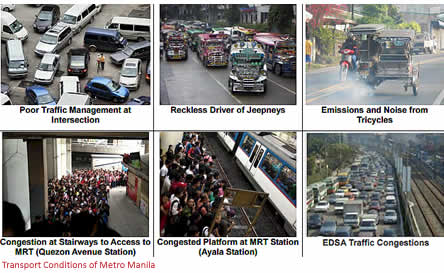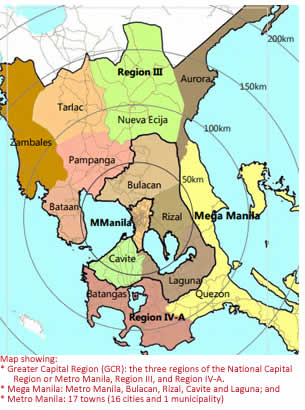 n an earlier editorial we
highlighted the pollution problem created by diesel and 2-stroke engines
in Philippine cities. Here we highlight the deleterious effects Metro
Manila's horrendous traffic problem has on the country's economy. n an earlier editorial we
highlighted the pollution problem created by diesel and 2-stroke engines
in Philippine cities. Here we highlight the deleterious effects Metro
Manila's horrendous traffic problem has on the country's economy.

Traffic moves around Metro
Manila in a god-awfully slow pace. And as people and vehicles in this
mega-metropolis increase that pace slows down even further.
At one point in the not
too distant past, a slow pace was easier to tolerate. After all
Filipinos are not too fixated with time the way westerners seem to be.
"We'll get there when we get there" emblemized the typical Pinoy's
approach top the issue. But that was then. And traffic moved much faster
"then" than it does today.
Workers typically get
up hours before dawn just to make it to the workplace by eight o'clock.
In the process, battle for space in overcrowded buses and jeepneys,
(and for those unlucky enough to be riding non-air-conditioned
vehicles), expose their lungs to all kinds of toxic fumes as their ride
crawls, through rush-hour traffic over dilapidated roads.
In a recent speech,
Sen. Paolo Benigno Bam Aquino IV cited a joint study by the National
Economic Development Authority (NEDA) and the Japan International Cooperation Agency (JICA) which warned that if Metro Manila's traffic
problems are left uncorrected, economic losses would likely increase 150
percent from today's P2.4 billion per day to P6 billion per day by
2030.
Cooperation Agency (JICA) which warned that if Metro Manila's traffic
problems are left uncorrected, economic losses would likely increase 150
percent from today's P2.4 billion per day to P6 billion per day by
2030.
The study pointed out
that the Greater Capital Region (GCR) which is made up of Metro Manila,
Central Luzon, and Calabarzon had the fastest population growth in the
entire country; going from 15.4 million in 1980, 20.6 million in 1990,
and 34.6 million in 2010.
The population density
for Metro Manila alone stood at 191 persons per hectare that year. If
you think that's high (and it is), Manila and Mandaluyong today have
population densities that surpass 650 persons per hectare.
The NEDA-JICA study
direly predicts that " If nothing is done, the situation in 2030 will
become a nightmare. All roads will be saturated. Negative impact on
economic, social and environmental aspects will be so large deterring
the function and livability of Metro Manila."
What must be done
We believe that first
and foremost, driver's education courses must be mandatory for all
Filipino high school students. The emphasis should be on strict
adherence to the rules of the road as well as road courtesy. Today's
Filipinos are skilled drivers but lack both courtesy behind the wheel
and knowledge of driving rules. The study makes no mention of driver
education, but in a densely populated area like Metro Manila, every
person must know and follow the same set of rules so that order and
harmony are maintained. A properly implemented "driver's ed" program
will insure that all Filipino drivers know the rules of the road.
We agree with the
study's other suggestions some of which are:
Promote urbanization
in areas adjoining Metro Manila to help decongest it. And link these
adjoining urban centers with efficient transport systems (roads and/or
rail) to efficiently move people and goods between them.
Invest massively as
much as 5% of GDP - on infrastructure projects in the transport sector.
Clear backlogs of
un-implemented (but still valid) road projects. For Metro Manila, this
means completing the missing links of C-2, C-3, C-4, and C-5, as well as
building the flyovers/interchanges on or before 2016.
Expand the mass
transit network to handle as much as 9.1 million person trips per day
compared to the today's level of just 1.5 million.
Senator Aquino rightly
points out that steps must be taken today if we are to prevent traffic
in Metro Manila from eventually grinding to a halt. We owe it to our
kids, and their kids to make this most important of regions clean,
livable, and efficient once again, with traffic moving at a brisk steady
pace anytime in the day or night.
Published 8/26/2015 |